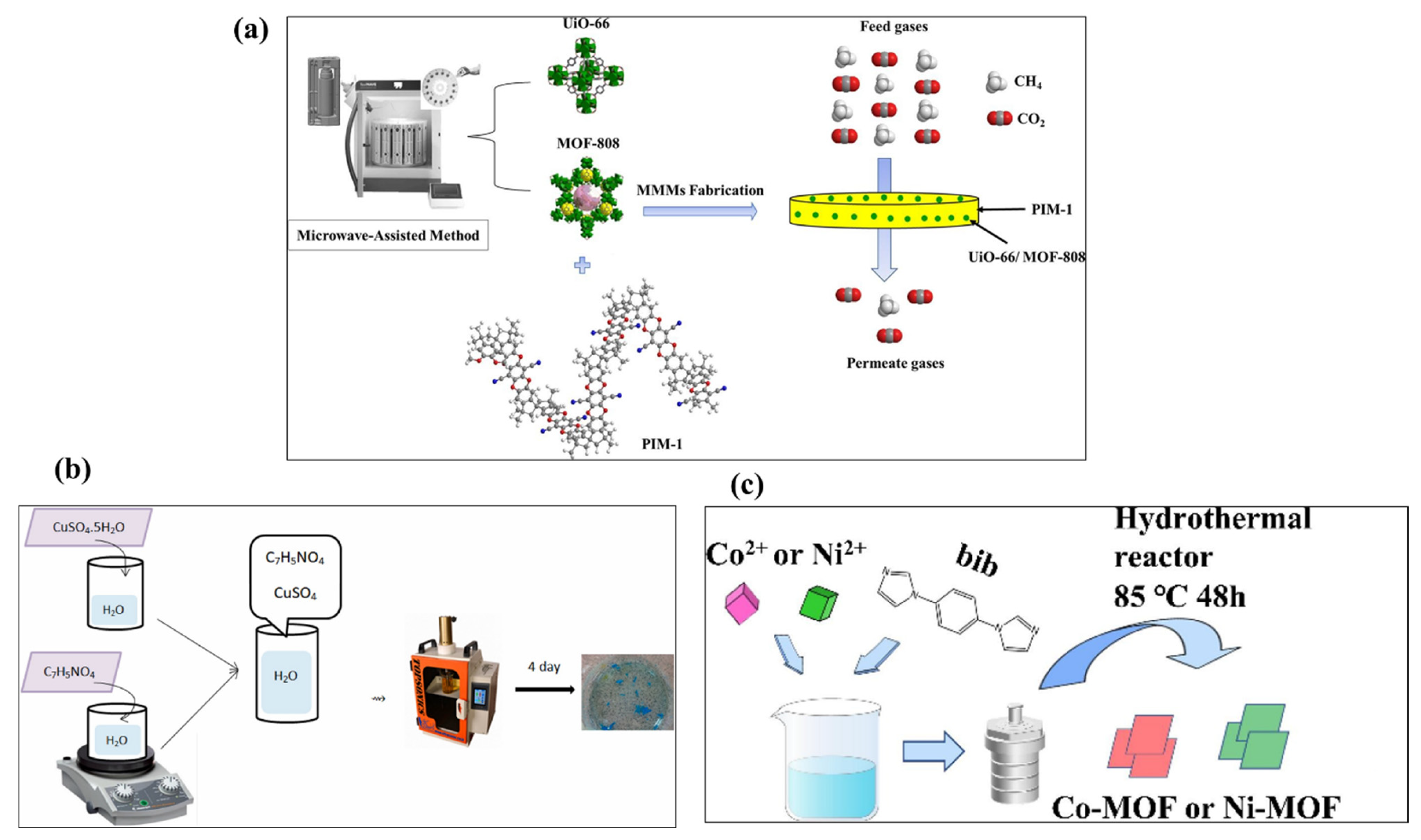Recent Progress in MOFs and MOF-Derived Materials for Gas Sensing Applications
Abstract
1. Introduction
2. Synthetic Process for MOFs
2.1. Microwave Method
2.2. Sonochemical Method
2.3. Hydrothermal Method
2.4. Electrochemical Method
3. MOF-Based Materials in Sensing Applications
3.1. MOF and MOFs/Composite
3.2. MOF-Derived Materials
4. Conclusions and Future Perspectives
Author Contributions
Funding
Conflicts of Interest
References
- Luo, F.; Che, Y.-X.; Zheng, J.M. Construction of microporous metal–organic frameworks (MOFs) by Mn–O–C rod-like secondary building units (SBUs): Solvothermal synthesis, structure, thermostability, and magnetic properties. Inorg. Chem. Commun. 2008, 11, 358–362. [Google Scholar] [CrossRef]
- Samanidou, V.F.; Deliyanni, E.A. Metal Organic Frameworks: Synthesis and Application. Molecules 2020, 25, 960. [Google Scholar] [CrossRef] [PubMed]
- Thiam, A.; Lopez-Ruiz, J.A.; Barpaga, D.; Garcia-Segura, S. The Surge of Metal–Organic-Framework (MOFs)-Based Electrodes as Key Elements in Electrochemically Driven Processes for the Environment. Molecules 2021, 26, 5713. [Google Scholar] [CrossRef] [PubMed]
- Li, Z.; Wang, Y.; Zhang, J.; Cheng, S.; Sun, Y. A Short Review of Advances in MOF Glass Membranes for Gas Adsorption and Separation. Membranes 2024, 14, 99. [Google Scholar] [CrossRef]
- Gomez, G.E.; dos Santos Afonso, M.; Baldoni, H.A.; Roncaroli, F.; Soler-Illia, G.J.A.A. Luminescent Lanthanide Metal Organic Frameworks as Chemosensing Platforms towards Agrochemicals and Cations. Sensors 2019, 19, 1260. [Google Scholar] [CrossRef]
- Pettinari, C.; Tombesi, A. MOFs for Electrochemical Energy Conversion and Storage. Inorganics 2023, 11, 65. [Google Scholar] [CrossRef]
- Xie, Y.; Zhang, T.; Wang, B.; Wang, W. The Application of Metal–Organic Frameworks in Water Treatment and Their Large-Scale Preparation: A Review. Materials 2024, 17, 1972. [Google Scholar] [CrossRef]
- Saeb, M.R.; Rabiee, N.; Mozafari, M.; Mostafavi, E. Metal-Organic Frameworks (MOFs)-Based Nanomaterials for Drug Delivery. Materials 2021, 14, 3652. [Google Scholar] [CrossRef]
- Králik, M.; Koóš, P.; Markovič, M.; Lopatka, P. Organic and Metal–Organic Polymer-Based Catalysts—Enfant Terrible Companions or Good Assistants? Molecules 2024, 29, 4623. [Google Scholar] [CrossRef]
- Xie, W.-J.; Mulina, O.M.; Terent’ev, A.O.; He, L.-N. Metal–Organic Frameworks for Electrocatalytic CO2 Reduction into Formic Acid. Catalysts 2023, 13, 1109. [Google Scholar] [CrossRef]
- Cui, Z.; Wang, H.; Yang, K.; Shen, Y.; Qin, K.; Yuan, P.; Li, E. Highly Sensitive and Selective Defect WS2 Chemical Sensor for Detecting HCHO Toxic Gases. Sensors 2024, 24, 762. [Google Scholar] [CrossRef]
- Nalimova, S.S.; Shomakhov, Z.V.; Kozodaev, D.A.; Rybina, A.A.; Buzovkin, S.S.; Bui, C.D.; Novikov, I.A.; Moshnikov, V.A. VOC Gas Sensors Based on Zinc Stannate Nanoparticles Decorated with Silver. Nanomaterials 2024, 14, 1993. [Google Scholar] [CrossRef]
- David, E.; Niculescu, V.-C. Volatile Organic Compounds (VOCs) as Environmental Pollutants: Occurrence and Mitigation Using Nanomaterials. Int. J. Environ. Res. Public Health 2021, 18, 13147. [Google Scholar] [CrossRef] [PubMed]
- He, Y.; Jiao, M. A Mini-Review on Metal Oxide Semiconductor Gas Sensors for Carbon Monoxide Detection at Room Temperature. Chemosensors 2024, 12, 55. [Google Scholar] [CrossRef]
- Chakraborthy, A.; Nuthalapati, S.; Nag, A.; Afsarimanesh, N.; Alahi, M.E.E.; Altinsoy, M.E. A Critical Review of the Use of Graphene-Based Gas Sensors. Chemosensors 2022, 10, 355. [Google Scholar] [CrossRef]
- Kotbi, A.; Benyoussef, M.; Ressami, E.M.; Lejeune, M.; Lakssir, B.; Jouiad, M. Gas Sensors Based on Exfoliated g-C3N4 for CO2 Detection. Chemosensors 2022, 10, 470. [Google Scholar] [CrossRef]
- Bai, H.; Shi, G. Gas Sensors Based on Conducting Polymers. Sensors 2007, 7, 267–307. [Google Scholar] [CrossRef]
- Li, W.; Zhang, Y.; Long, X.; Cao, J.; Xin, X.; Guan, X.; Peng, J.; Zheng, X. Gas Sensors Based on Mechanically Exfoliated MoS2 Nanosheets for Room-Temperature NO2 Detection. Sensors 2019, 19, 2123. [Google Scholar] [CrossRef]
- Vaishag, P.V.; Noh, J.-S. A Comparative Review of Graphene and MXene-Based Composites towards Gas Sensing. Molecules 2024, 29, 4558. [Google Scholar] [CrossRef]
- Ren, X.; Xu, Z.; Zhang, Z.; Tang, Z. Enhanced NO2 Sensing Performance of ZnO-SnO2 Heterojunction Derived from Metal-Organic Frameworks. Nanomaterials 2022, 12, 3726. [Google Scholar] [CrossRef]
- Zhang, Y.; Jia, C.; Wang, Q.; Kong, Q.; Chen, G.; Guan, H.; Dong, C. MOFs-Derived Porous NiFe2O4 Nano-Octahedrons with Hollow Interiors for an Excellent Toluene Gas Sensor. Nanomaterials 2019, 9, 1059. [Google Scholar] [CrossRef] [PubMed]
- Qi, B.; Wang, X.; Wang, X.; Cheng, J.; Shang, Y. Synthesis and H2S-Sensing Properties of MOF-Derived Cu-Doped ZnO Nanocages. Nanomaterials 2022, 12, 2579. [Google Scholar] [CrossRef] [PubMed]
- Klinowski, J.; Paz, F.A.A.; Silva, P.; Rocha, J. Microwave-Assisted Synthesis of Metal–Organic Frameworks. Dalton Trans. 2011, 40, 321–330. [Google Scholar] [CrossRef]
- Zhao, Z.; Li, H.; Zhao, K.; Wang, L.; Gao, X. Microwave-assisted synthesis of MOFs: Rational design via numerical simulation. Chem. Eng. J. 2022, 428, 131006. [Google Scholar] [CrossRef]
- Phan, P.T.; Hong, J.; Tran, N.; Le, T.H. The Properties of Microwave-Assisted Synthesis of Metal–Organic Frameworks and Their Applications. Nanomaterials 2023, 13, 352. [Google Scholar] [CrossRef] [PubMed]
- Tanan, W.; Panpinit, S.; Saengsuwan, S. Comparison of microwave-assisted and thermal-heated synthesis of P(HEMA-co-AM)/PVA interpenetrating polymer network (IPN) hydrogels for Pb(II) removal from aqueous solution: Characterization, adsorption and kinetic study. Eur. Polym. J. 2021, 143, 110193. [Google Scholar] [CrossRef]
- Taylor-Pashow, K.M.L.; Della Rocca, J.; Xie, Z.; Tran, S.; Lin, W. Postsynthetic Modifications of Iron-Carboxylate Nanoscale Metal-Organic Frameworks for Imaging and Drug Delivery. J. Am. Chem. Soc. 2009, 131, 14261–14263. [Google Scholar] [CrossRef]
- Khan, N.A.; Kang, I.J.; Seok, H.Y.; Jhung, S.H. Facile synthesis of nano-sized metal- organic frameworks, chromium-benzenedicarboxylate, MIL-101. Chem. Eng. J. 2011, 166, 1152–1157. [Google Scholar] [CrossRef]
- Zhu, Y.-J.; Chen, F. Microwave-Assisted Preparation of Inorganic Nanostructures in Liquid Phase. Chem. Rev. 2014, 114, 6462–6555. [Google Scholar]
- Yahia, M.; Lozano, L.A.; Zamaro, J.M.; Téllez, C.; Coronas, J. Microwave-assisted synthesis of metal–organic frameworks UiO-66 and MOF-808 for enhanced CO2/CH4 separation in PIM-1 mixed matrix membranes. Sep. Purif. Technol. 2024, 330, 125558. [Google Scholar] [CrossRef]
- Skoda, D.; Kazda, T.; Munster, L.; Hanulikova, B.; Styskalik, A.; Eloy, P.; Debecker, D.P.; Vilcakova, J.; Cech, O.; Simonikova, L.; et al. Microwave-assisted synthesis of platelet-like cobalt metal-organic framework, its transformation to porous layered cobalt-carbon nanocomposite discs and their utilization as anode materials in sodium-ion batteries. J. Energy Storage 2020, 27, 101113. [Google Scholar] [CrossRef]
- Dehane, A.; Merouani, S.; Chibani, A.; Hamdaoui, O.; Ashokkumar, M. Sonochemical and sono-assisted reduction of carbon dioxide: A critical review. Chem. Eng. Process. Process Intensif. 2022, 179, 109075. [Google Scholar] [CrossRef]
- Vaitsis, C.; Sourkouni, G.; Argirusis, C. Metal Organic Frameworks (MOFs) and ultrasound: A review. Ultrason. Sonochem. 2019, 52, 106–119. [Google Scholar] [CrossRef]
- Vaitsis, C.; Kanellou, E.; Pandis, P.K.; Papamichael, I.; Sourkouni, G.; Zorpas, A.A.; Argirusis, C. Sonochemical synthesis of zinc adipate Metal-Organic Framework (MOF) for the electrochemical reduction of CO2: MOF and circular economy potential. Sustain. Chem. Pharm. 2022, 29, 100786. [Google Scholar] [CrossRef]
- Abaszadeh, N.; Afzali, D.; Sargazi, G.; Golpayegani, A. Sonochemical-assisted method for efficient synthesis of Cu-MOF and evaluating its antibacterial properties. Heliyon 2024, 10, e31024. [Google Scholar] [CrossRef]
- Moradi, E.; Rahimi, R.; Safarifard, V.; Azari, S. A Sonochemically-Synthesized Microporous Metal-Organic Framework for the Rapid and Efficient Ultrasonic-Assisted Removal of Mercury (II) Ions in a Water Solution and a Study of the Antibacterial Activity. Proceedings 2019, 41, 31. [Google Scholar] [CrossRef]
- Pokhrel, N.; Vabbina, P.K.; Pala, N. Sonochemistry: Science and Engineering. Ultrason. Sonochem 2016, 29, 104–128. [Google Scholar] [CrossRef]
- Wang, X.; Li, Q.; Yang, N.; Yang, Y.; He, F.; Chu, J.; Gong, M.; Wu, B.; Zhang, R.; Xiong, S. Hydrothermal synthesis of NiCo-based bimetal-organic frameworks as electrode materials for supercapacitors. J. Solid State Chem. 2019, 270, 370–378. [Google Scholar] [CrossRef]
- Qi, Q.; Liu, Z.; Chen, X.; Yu, J.; Li, X.; Wang, R.; Liu, Y.; Chen, J. Promoted electrochemical performance by MOF on MOF composite catalyst of microbial fuel cell: CuCo-MOF@ZIF-8 and the comparison between two-step hydrothermal method and dual-solution method. Biosens. Bioelectron. 2024, 264, 116693. [Google Scholar] [CrossRef]
- Wu, L.-Z.; Zhou, X.-Y.; Zeng, P.-C.; Huang, J.-Y.; Zhang, M.-D.; Qin, L. Hydrothermal synthesis of Ni(II) or Co(II)-based MOF for electrocatalytic hydrogen evolution. Polyhedron 2022, 225, 116035. [Google Scholar] [CrossRef]
- Zheng, X.; Chu, X.; Liang, H. Cu-MOF attached with pyrene-cored probes as a highly sensitive indicator for carbon monoxide in coal mine gas: Synthesis and performance. Microchem. J. 2024, 199, 109983. [Google Scholar] [CrossRef]
- Fan, L.; Zhang, J.; Zhao, Y.; Sun, C.; Li, W.; Chang, Z. A robust Eu-MOF as a multi-functional fluorescence sensor for detection of benzaldehyde, Hg2+, and Cr2O72−/CrO42−. Microchem. J. 2024, 196, 109712. [Google Scholar] [CrossRef]
- Liang, F.; Feng, Y.; Huang, S.; Duan, B.; Gao, D.; Cheng, Z.; Kong, L.; Guo, Y.; Liu, C.; Ding, T. Two In-MOFs containing pyridine dicarboxylic acids with different functional sites: Sensing of Fe3+ ion in water and selective gas capture. J. Mol. Struct. 2024, 1316, 139018. [Google Scholar] [CrossRef]
- Kong, L.-X.; Sun, J.-Z.; Shi, F.-F.; Li, Y.; Li, X.-Y. Temperature self-compensating fiber-optic misalignment sensor based on Cu-MOFs/PAN film cavity for detecting dimethyl carbonate gas. Opt. Laser Technol. 2025, 181, 111926. [Google Scholar] [CrossRef]
- Cai, S.; Huang, X.; Luo, M.; Xiong, D.; Pang, W.; Wang, M.; Wang, L.; Li, S.; Luo, P.; Gao, Z. High-performance ammonia sensor at room temperature based on 2D conductive MOF Cu3(HITP)2. Talanta 2024, 285, 127226. [Google Scholar] [CrossRef]
- Chen, S.; Duan, X.; Liu, C.; Liu, S.; Li, P.; Su, D.; Sun, X.; Guo, Y.; Chen, W.; Wang, Z. La-Ce-MOF nanocomposite coated quartz crystal microbalance gas sensor for the detection of amine gases and formaldehyde. J. Hazard. Mater. 2024, 467, 133672. [Google Scholar] [CrossRef]
- Jin, W.; Zhang, N.; Jia, M.; Wang, J.; Yang, S.; Liu, Y.; Chen, W. Dual functionalized Co3O4 porous cages with Pd and Co-MOF for acetone gas sensing under high humidity. Mater. Today Commun. 2024, 40, 109582. [Google Scholar] [CrossRef]
- Zhao, J.; Li, P.; Zhang, Q.; Ye, Z.; Wang, Y.; Tian, J.; Xu, Z.; Peng, N.; Ren, H.; Zhang, X. MOF nanoflowers-based flexible portable NO sensors for human airway inflammation detection. Chem. Eng. J. 2024, 499, 156184. [Google Scholar] [CrossRef]
- Yang, C.-R.; Huang, J.-G.; Huang, M.-J.; Shen, H.-Y.; Tseng, S.-F. High-performance NO2 gas sensors based on vanadium metal organic frameworks (V-MOFs) on flexible graphene electrodes. J. Alloys Compd. 2024, 1008, 176675. [Google Scholar] [CrossRef]
- Yu, Y.-H.; Lin, X.-Y.; Teng, K.-L.; Hu, C.-C.; Wang, W.-Y.; Hung, Y.-H.; Tseng, H.-Y.; Luo, K.-H.; Yeh, J.-M.; Lu, K.-L.; et al. Semiconductive (Cu–S)n Metal–Organic Frameworks Hybrid Polyaniline Nanocomposites as Hydrogen Sulfide Gas Sensor. Surf. Interfaces 2024, 44, 103698. [Google Scholar] [CrossRef]
- Wang, X.; Xu, X.; Zhou, T.; Zhang, T. Nanoscale MOF-74-based QCM gas sensor for CO2 detection at room temperature. Sens. Actuators B Chem. 2024, 413, 135874. [Google Scholar] [CrossRef]
- Wei, X.; Yang, X.; Guo, Y.; Liu, Y.; Wang, L.; Wang, Q.; Cheng, L.; Jiao, Z. UV-enhanced Mg:MOF-ZnO sensor for n-butanol gas detection at a lower operating temperature. Appl. Surf. Sci. 2024, 678, 161138. [Google Scholar] [CrossRef]
- Maji, B.; Singh, P.; Badhulika, S. A highly sensitive and fully flexible Fe-Co metal-organic framework hydrogel based gas sensor for ppb level detection of acetone. Appl. Surf. Sci. 2024, 678, 161047. [Google Scholar] [CrossRef]
- Cai, H.; Luo, H.; Hu, F.; Wang, J.; Zhou, J.; An, D. High-response n-butanol gas sensor based on quasi-Zn-MOFs with tunable surface oxygen vacancies. J. Alloys Compd. 2025, 1010, 177274. [Google Scholar] [CrossRef]
- Liu, Z.; Kang, M.; Zhang, Z.; Yue, C.; Mu, Y.; Yang, Z.; Wang, F.; Dastan, D.; Yin, X.-T.; Ma, X. One-step preparation of La2O3-modified MOF-SnO2 gas sensor for ethanol detection. Appl. Surf. Sci. 2025, 681, 161594. [Google Scholar] [CrossRef]
- Van Nguyen, M.; Kim, T.-U.; Nguyen, L.H.T.; Mirzaei, A.; Pham, A.T.T.; Tran, T.Q.; Mai, N.X.D.; Tran, N.Q.; Kim, Y.; Phan, T.B.; et al. Efficient low-temperature detection of CO gas by various metalated porphyrinic-Al-based MOF (Cu and Co) materials. Sens. Actuators B Chem. 2025, 424, 13691. [Google Scholar] [CrossRef]
- Fang, H.; Ma, X.; Li, S.; Tan, R.; Chen, H.; Zhang, J.; Yuan, K.; Wang, D. H2S gas sensing based on CuNi MOFs derivative with TiO2 quantum dot decoration applied for meat freshness detection. Sens. Actuators B Chem. 2025, 422, 136612. [Google Scholar] [CrossRef]
- Ding, J.; Wang, Q.; Liu, X.; Li, S.; Li, H. Ultrasensitive detection of hazardous gas at room temperature enabled by MOF@MXene 0D-2D heterostructure. J. Hazard. Mater. 2024, 480, 136261. [Google Scholar] [CrossRef]
- Liu, H.; Chen, Q.; Xu, T.; Liu, H.; Miao, L.; Liu, W.; Cheng, J.; Yin, S.; Wang, C.; Zhao, J. Chemiresistive triethylamine detection based on the novel Ti3C2Tx/Co-BDC gas sensor. Sens. Actuators B Chem. 2025, 423, 136738. [Google Scholar] [CrossRef]
- Zhang, S.; Zhao, Z.; Jia, L.; Guo, X.; Yang, R.; Deng, Q.; Zhang, D. Ultrahigh sensitive and selectivity NO2 gas sensors based on Sn-MOF derivates at low temperature. Sens. Actuators B Chem. 2024, 417, 136073. [Google Scholar] [CrossRef]
- Yan, H.; Wang, J.; Shi, N.; Han, Y.; Zhang, S.; Zhao, G. A flexible and wearable chemiresistive ethylene gas sensor modified with PdNPs-SWCNTs@Cu-MOF-74 nanocomposite: A targeted strategy for the dynamic monitoring of fruit freshness. Chem. Eng. J. 2024, 488, 151142. [Google Scholar] [CrossRef]
- Yang, Y.; Yue, J.; Zhang, X.; Ren, B.; Fu, S.; Sun, Y.; Luo, Z. Accordion-like ZIF-8/MoO3 composite gas sensor for highly selective and sensitive H2S detection. Ceram. Int. 2024, 50, 38253–38262. [Google Scholar] [CrossRef]
- Wang, X.; Ma, Q.; Wang, Y.; Li, L.; Zhao, D.; Zhang, H.; Li, B. Bimetallic MOFs-derived hierarchical WO3/ZnWO4/CoWO4 heterostructures for enhanced n-butanol gas-sensing performance. Chem. Phys. Lett. 2024, 844, 141260. [Google Scholar] [CrossRef]
- Shah, S.; Hussain, S.; Khan, L.A.; Yusuf, K.; Manavalan, R.K.; Tianyan, Y.; Zhang, X.; Liu, G.; Qiao, G. ppb-level H2 gas-sensor based on porous Ni-MOF derived NiO@CuO nanoflowers for superior sensing performance. Mater. Res. Bull. 2024, 180, 113021. [Google Scholar] [CrossRef]
- Zhang, S.; Pu, Y.; Du, X.; Cao, S.; Zhu, D. Effect of Ce doping and MOF-derived structure on gas sensing performance of SnO2 to ethylene glycol. Mater. Sci. Eng. B 2024, 302, 117247. [Google Scholar] [CrossRef]
- Hussain, S.; Begi, A.N.; Amu-Darko, J.N.O.; Yusuf, K.; Manavalan, R.K.; Iqbal, A.; Zhang, X.; Qiao, G.; Liu, G. MOF-derived Mo-doped Co3O4: A hierarchical yeast-like structure for superior carbon monoxide sensing. Sens. Actuators B Chem. 2024, 420, 136489. [Google Scholar] [CrossRef]
- Geng, W.; Song, P.; Cao, X.; Duan, L. Bimetallic Ni/V-MOFs-derived Ni3V2O8@NiO hollow microspheres for ultrasensitive detection of triethylamine. Appl. Surf. Sci. 2024, 670, 160637. [Google Scholar] [CrossRef]
- Xiao, D.; Wang, Y.; Zhang, D.; Liu, Y.; Wang, H.; Li, Y.; Wei, H.; Wang, S.; Sun, M.; Sun, M. CuO/ZnO hollow nanocages derived from metal−organic frameworks for ultra-high and rapid response H2S gas sensor. Ceram. Int. 2024, 50, 15767–15779. [Google Scholar] [CrossRef]
- Lu, Z.J.; Yue, J.H.; Xu, J.C.; Hong, B.; Li, J.; Zeng, Y.X.; Peng, X.L.; Chen, H.W.; Wang, X.Q. Highly-enhanced toluene gas-sensing behavior of high-valent metal-cations doped Co3O4 nanostructures derived from ZIF-67 MOF. Chem. Phys. 2024, 581, 112266. [Google Scholar] [CrossRef]
- Ding, Q.; Li, H.; Liu, W.; Huang, D.; Tan, X.; Zhao, M.; Cheng, Q.; Yi, M.; Ren, Y. Fast response triethylamine sensor based on MOF-derived coral flower-like Fe-doped Co3O4. Mater. Sci. Semicond. Process. 2024, 180, 108557. [Google Scholar] [CrossRef]
- Begi, A.N.; Hussain, S.; Liaqat, M.J.; Alsaiari, N.S.; Ouladsmane, M.; Qiao, G.; Liu, G. Unlocking low-concentration NH3 gas sensing: An innovative MOF-derived In2O3/Co3O4 nanocomposite approach. Mater. Sci. Semicond. Process. 2024, 181, 108641. [Google Scholar] [CrossRef]
- Hussain, S.; Peng, L.; Amu-Darko, J.N.O.; Shahid, A.; Yusuf, K.; Wang, S.; Liaqat, M.J.; Manavalan, R.K.; Zhang, X.; Qiao, G. ZIF-67 MOF derived in-doped Co3O4 nanoflowers for H2S gas-sensing performances. Mater. Sci. Semicond. Process. 2024, 184, 108840. [Google Scholar] [CrossRef]
- Zhang, S.; Ling, W.; Zhao, T.; Pu, Y.; Cao, S.; Zhu, D. High response ZnO gas sensor derived from Tb@Zn-MOFs to acetic acid under UV excitation. Sens. Actuators A Phys. 2024, 365, 114862. [Google Scholar] [CrossRef]
- Begi, A.N.; Hussain, S.; Amu-Darko, J.N.O.; Shah, S.; Junhao, W.; Zhang, X.; Yusuf, K.; Manavalan, R.K.; Qiao, G.; Liu, G. Low-concentration H2S gas sensors based on MOF-derived Co3O4 nanomaterials. Sens. Actuators A Phys. 2024, 378, 115776. [Google Scholar] [CrossRef]
- Peng, H.; Yang, J.; Lin, C.; Qi, L.; Li, L.; Shi, K. Gas-sensitive performance of metal-organic framework-derived CuO NPs/Ti3C2TX MXene heterostructures for efficient NO2 detection at room temperature. J. Alloys Compd. 2024, 980, 173657. [Google Scholar] [CrossRef]
- Geng, W.; Song, P.; Cao, X.; Duan, L. NiO/ZrO2 hollow microspheres derived from bimetallic Ni/Zr-MOFs for fast and sensitive detection of triethylamine. J. Alloys Compd. 2024, 1006, 176277. [Google Scholar] [CrossRef]
- Geng, W.; Song, P.; Duan, L.; Luan, T. MOFs-derived In2O3 hollow microtubes/ZnCo2O4 microflowers for fast and sensitive detection of n-butanol. Sens. Actuators B Chem. 2025, 423, 136803. [Google Scholar] [CrossRef]
- Hu, Z.; Yang, X.; Zhang, Y.; Sun, Z.; Liu, W.; Pan, G.; Wang, H.; Sun, M. High-performance trimethylamine gas sensor based on Sn-W co-doped MOF-derived hollow flower-like nickel oxide. J. Alloys Compd. 2025, 1010, 177110. [Google Scholar] [CrossRef]
- Wang, S.; Liu, Q.; Shao, J.; Pan, G.; Qi, Y.; Qiu, M. MOF-derived Au functional CeO2/Co3O4 heterostructure gas sensor with moisture resistance for low-temperature and efficient toluene detection. J. Alloys Compd. 2025, 1010, 177358. [Google Scholar] [CrossRef]
- Duan, P.; Wang, H.; Zhou, H.; Zhang, S.; Meng, X.; Duan, Q.; Jin, K.; Sun, J. MOF-derived xPd-NPs@ZnO porous nanocomposites for ultrasensitive ppb-level gas detection with photoexcitation: Design, diverse-scenario characterization, and mechanism. J. Colloid Interface Sci. 2024, 660, 974–988. [Google Scholar] [CrossRef] [PubMed]
- Xin, J.; Wang, W.; Xie, L.; Li, X.; Yao, Y.; Zhao, X.; Zhu, Z. MOF-derived Al3+-doped Co3O4 nanocomposites for highly n-butanol gas sensing performance at low operating temperature. J. Alloys Compd. 2024, 978, 173341. [Google Scholar] [CrossRef]
- Majhi, S.M.; Kim, J.-Y.; Mirzaei, A.; Surya, S.G.; Kim, H.W.; Kim, S.S. MOF-derived SnO2 nanoparticles for realization of ultrasensitive and highly selective NO2 gas sensing. Sens. Actuators B Chem. 2024, 419, 136369. [Google Scholar] [CrossRef]
- Liu, Z.; Wang, Y.; Li, Y.; Sui, C.; Liu, Y.; Liu, Y.; Zhao, Y.; Liang, X.; Liu, F.; Lu, G. Bimetallic MOF derived mesoporous structure of Ru doped SnO2 enable high-sensitivity gas sensors for triethylamine in high humidity. Sens. Actuators B Chem. 2024, 405, 135275. [Google Scholar] [CrossRef]
- Xie, T.; Li, F.; Song, P.; Fang, M.; Duan, L.; Zhang, Q.; Geng, W. High responsive n-butanol gas sensor based on MOFs-derived Cr2O3/RGO p-p heterojunctions materials. J. Alloys Compounds 2024, 1002, 175271. [Google Scholar] [CrossRef]
- Montoro, C.; Kim, J.-Y.; Mirzaei, A.; Lee, J.-H.; Sayegh, S.; Makhoul, E.; Iatsunskyi, I.; Coy, E.; Bechelany, M.; Kim, H.W.; et al. MOF-derived metal oxide (Cu, Ni, Zn) gas sensors with excellent selectivity towards H2S, CO and H2 gases. Compos. Part B Eng. 2024, 283, 111637. [Google Scholar] [CrossRef]
- Liu, W.; Li, H.; Huang, D.; Tan, X.; Zhao, M.; Cheng, Q.; Yi, M.; Ding, Q.; Ren, Y.; Liu, G. Engineering α-MoO3/TiO2 heterostructures derived from MOFs/MXene hybrids for high-performance triethylamine sensor. Chem. Eng. J. 2024, 483, 149340. [Google Scholar] [CrossRef]
- Lu, X.; Qu, Y.; Zhang, F.; Ding, Z.; Zheng, H.; Lei, Y.; Liu, S.; Li, S. A sensitive NH3 chemiresistive sensor with wide detection range: Employing a MOF-derived mesoporous carbon composite with polyaniline. Sens. Actuators B Chem. 2024, 416, 135938. [Google Scholar] [CrossRef]
- Ding, Y.; Du, B.; Guo, X.; Dong, Y.; Zhang, M.; Jin, W.; Gao, C.; Peng, D.; He, Y. An ultrasensitive NO2 gas sensor based on a NiO-SnO2 composite with a sub-ppb detection limit at room temperature. Sens. Actuators B Chem. 2024, 414, 135916. [Google Scholar] [CrossRef]
- Qiao, Y.; Zhang, J.; Liu, J.; Liu, Y.; Zhang, X.; Yang, Z.; Yin, X.; Gao, J.; Wang, C.; Lu, H. MOF-derived porous In2O3 nanospheres sensitized by CdS quantum dots: A ppb-level NO2 sensor with ultra-high response at room-temperature. J. Alloys Compd. 2024, 997, 174889. [Google Scholar] [CrossRef]
- Gao, S.; Li, X.; Wang, C.; Yuan, R.; Zhang, Q. High-performance triethylamine gas sensor with low working temperature based on amorphous derivative from ZIF-67. J. Alloys Compd. 2024, 998, 174952. [Google Scholar] [CrossRef]
- Qin, C.; Wei, Z.; Zhao, X.; Cao, J.; Wang, Y. High-temperature hydrogen sensor based on MOFs-derived Mn-doped In2O3 hollow nanotubes. Int. J. Hydrog. Energy 2024, 78, 1024–1033. [Google Scholar] [CrossRef]
- Li, N.; Hu, J.; Li, J.; Cheng, M.; Wei, T.; Liu, Q.; Wang, R.; Li, W.; Ling, Y.; Zhang, Y.; et al. Cu-MOF-74-derived Cu2O/CuO-C nanocomposite as an effective chemiresistive sensor for detection of NO2 at room temperature. J. Alloys Compd. 2024, 976, 173074. [Google Scholar] [CrossRef]
- Maji, B.; Dash, P. Investigation into the enhanced gas sensing performance for CH4: Comparative study of MOF-derived and traditionally synthesized ZnCo2O4 flower based composite. Sens. Actuators B Chem. 2024, 403, 135182. [Google Scholar] [CrossRef]
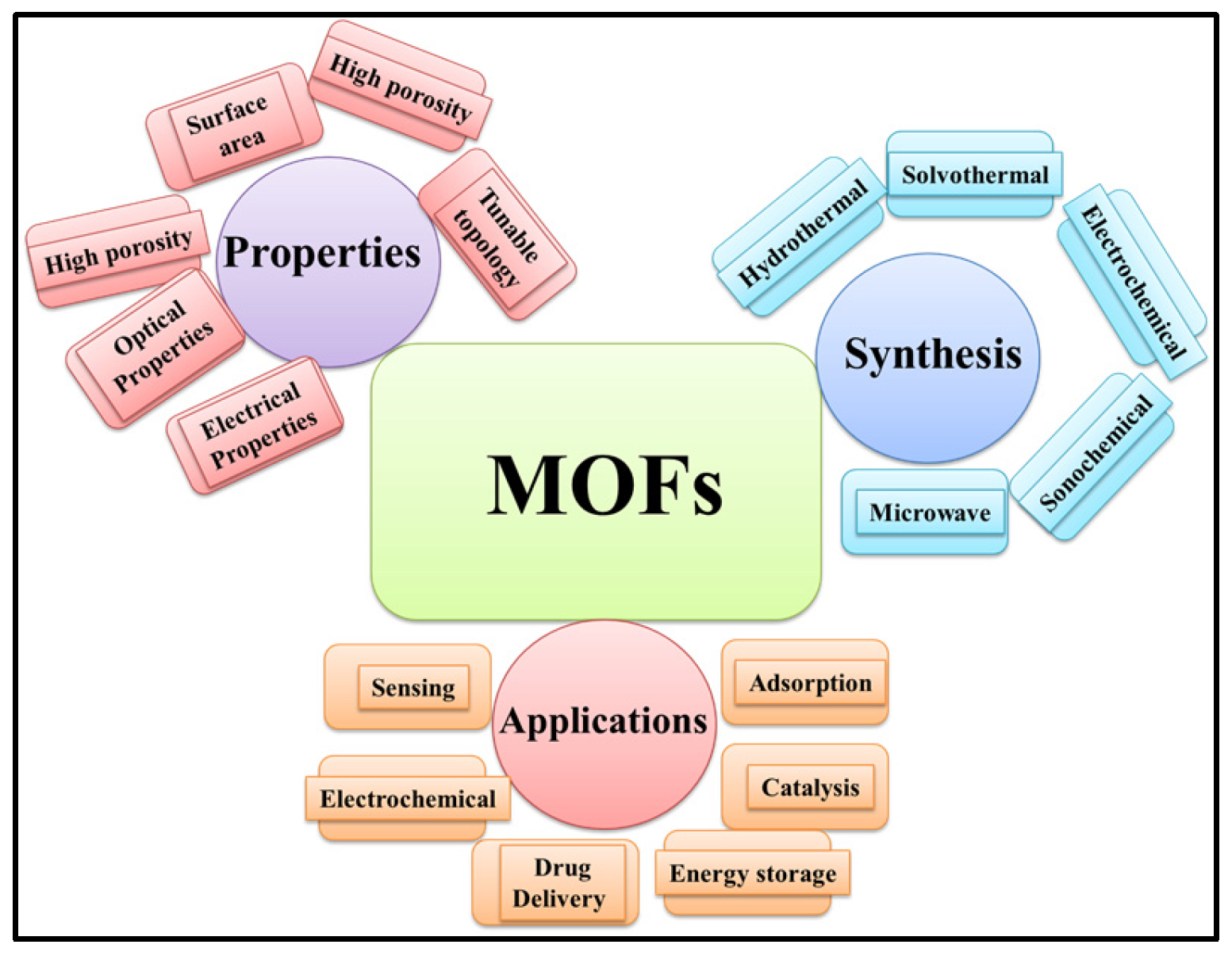
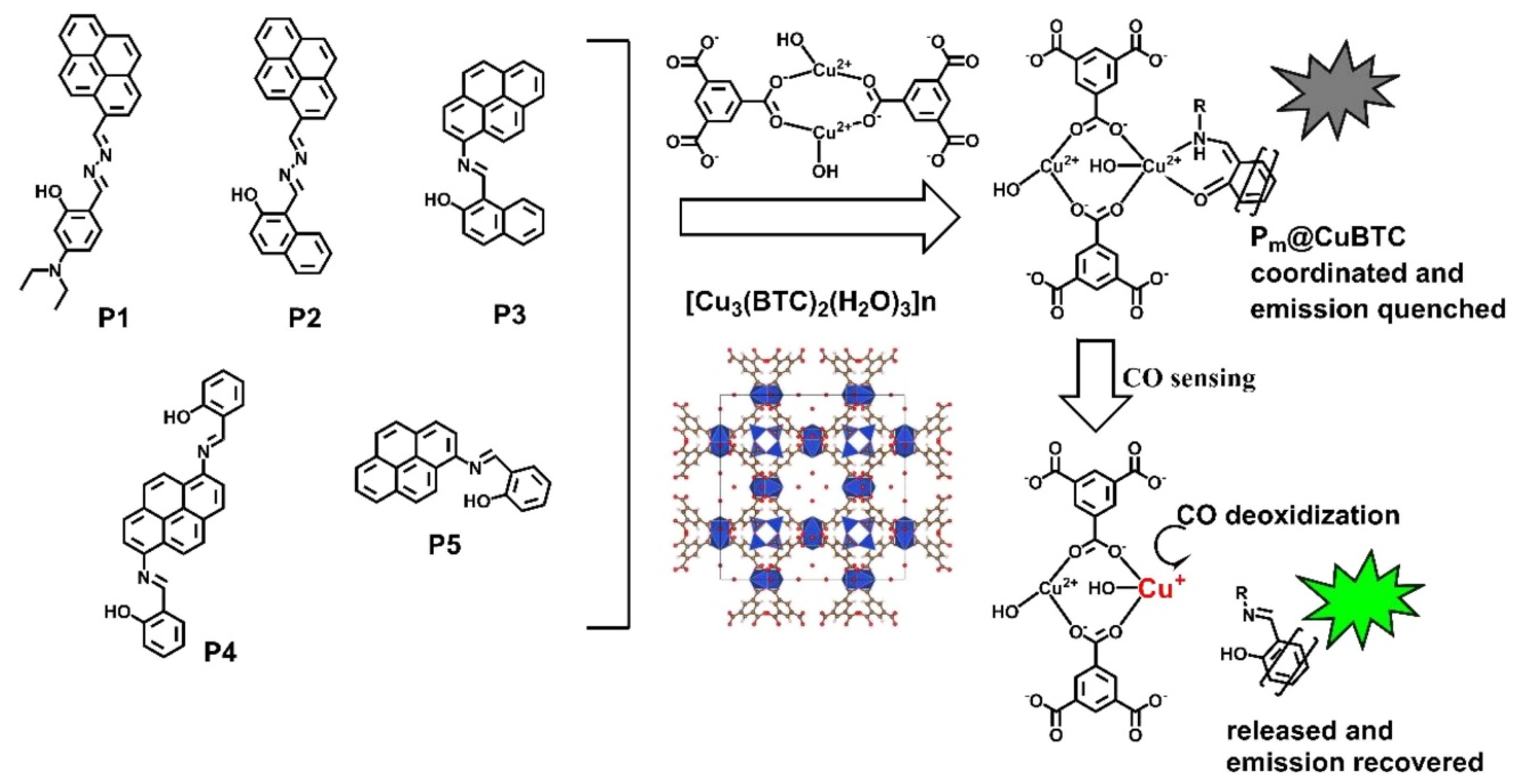
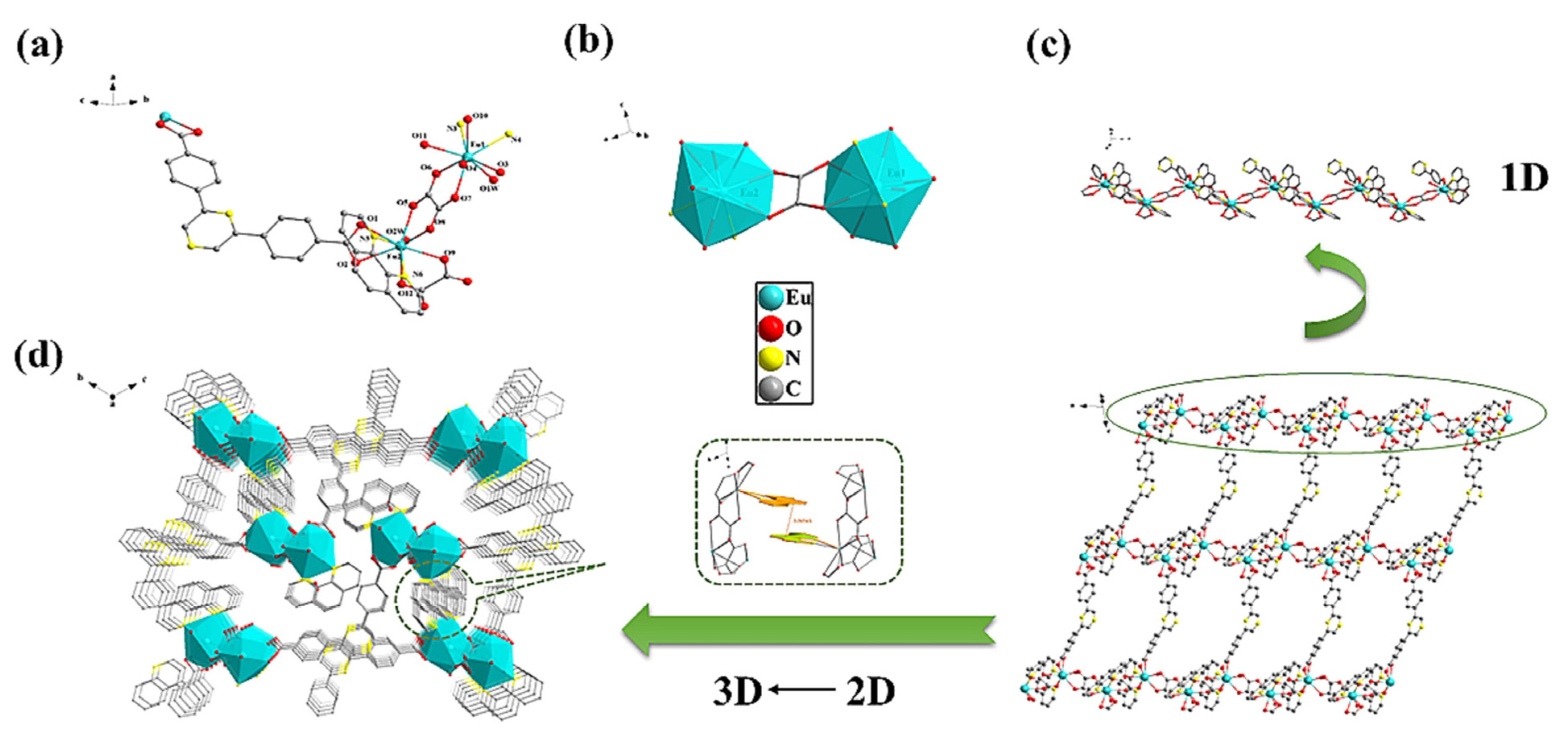
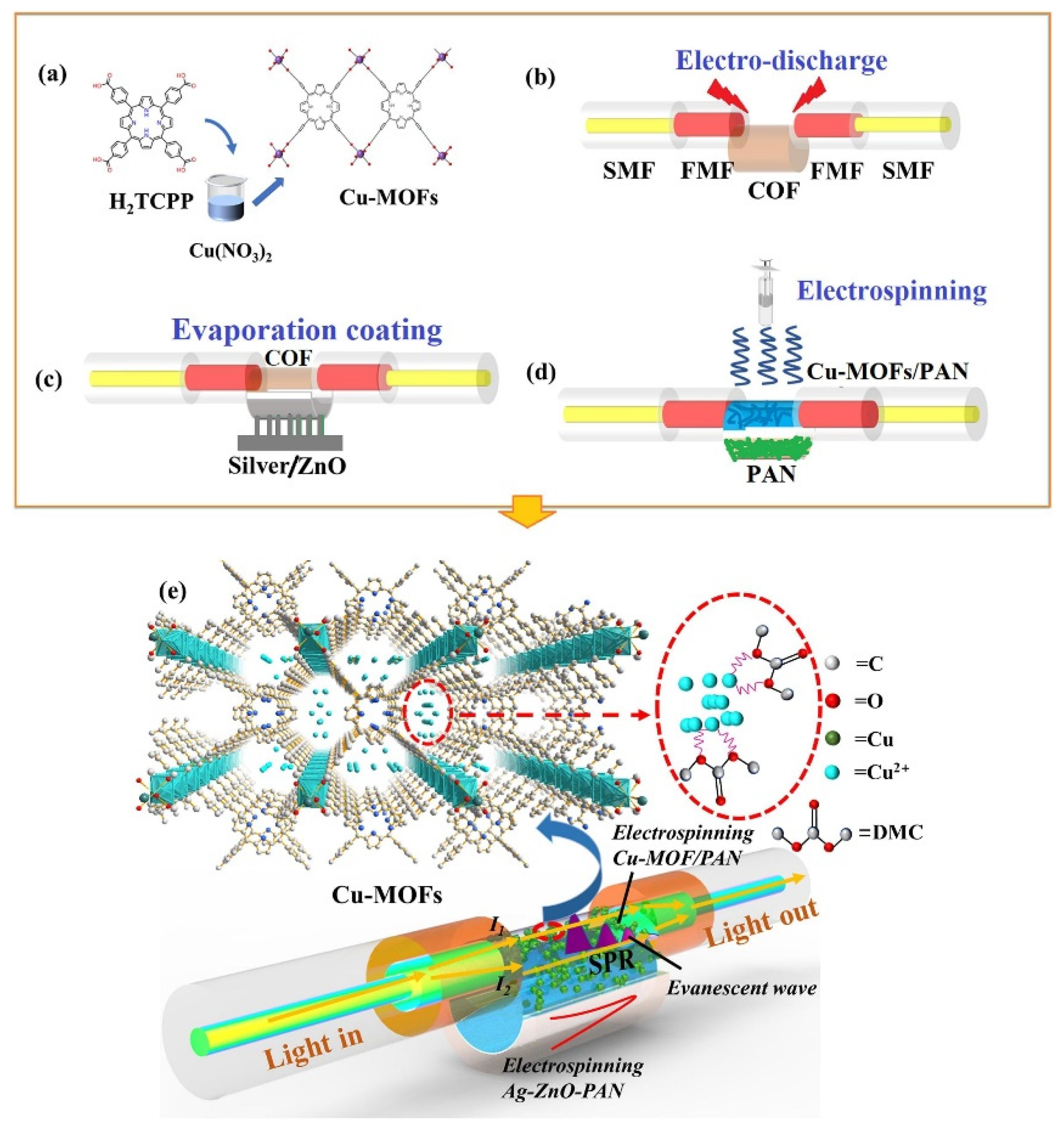

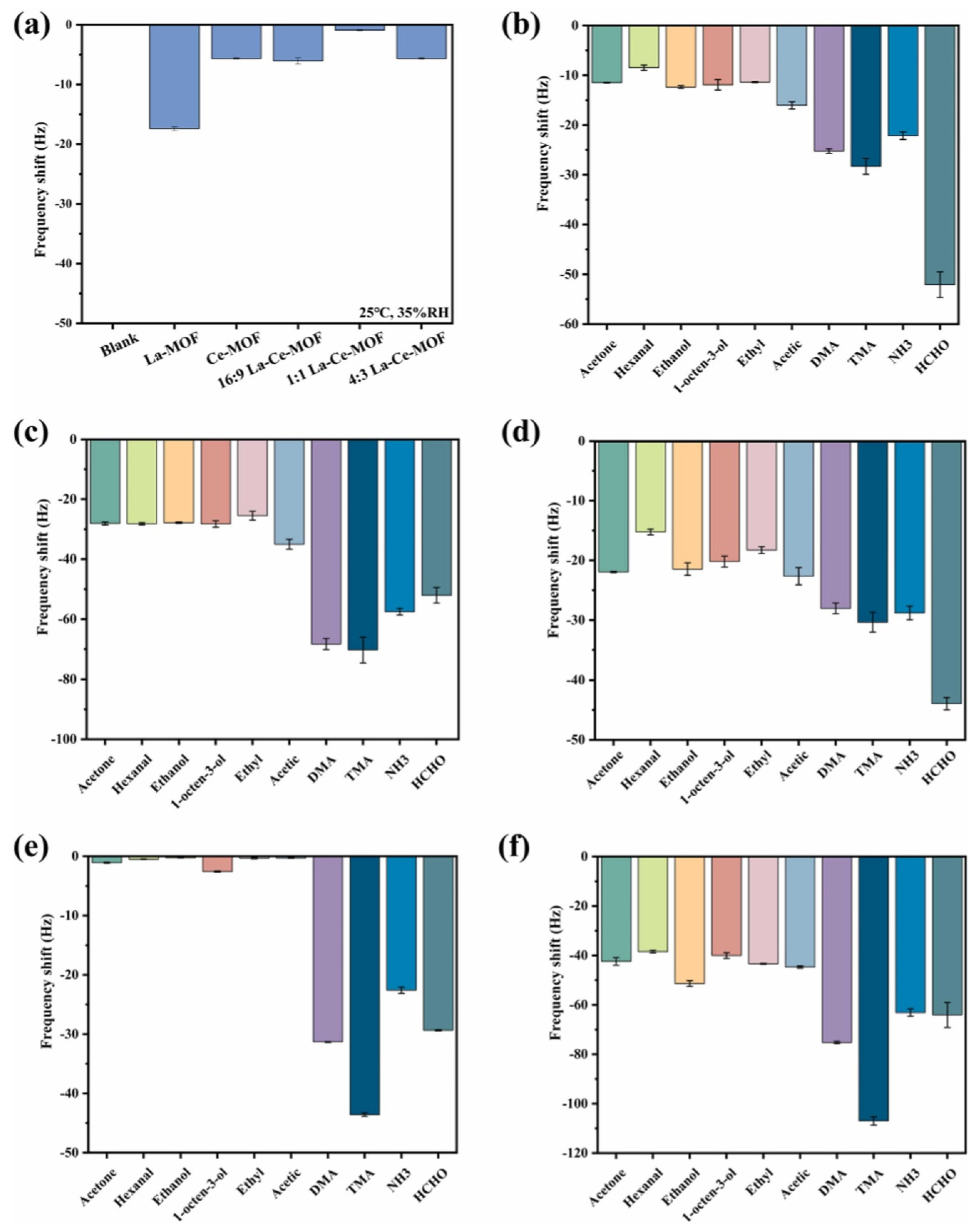
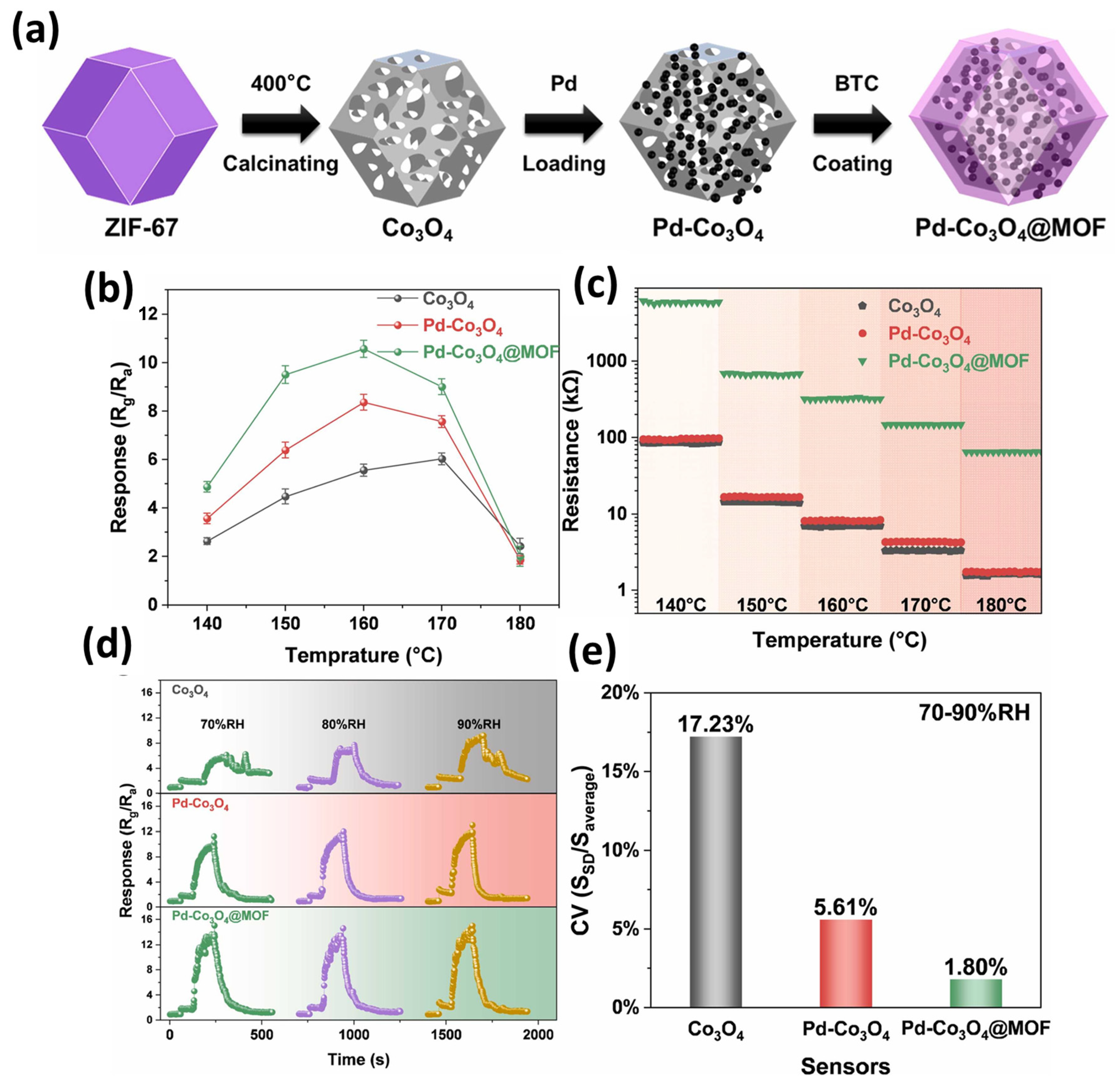
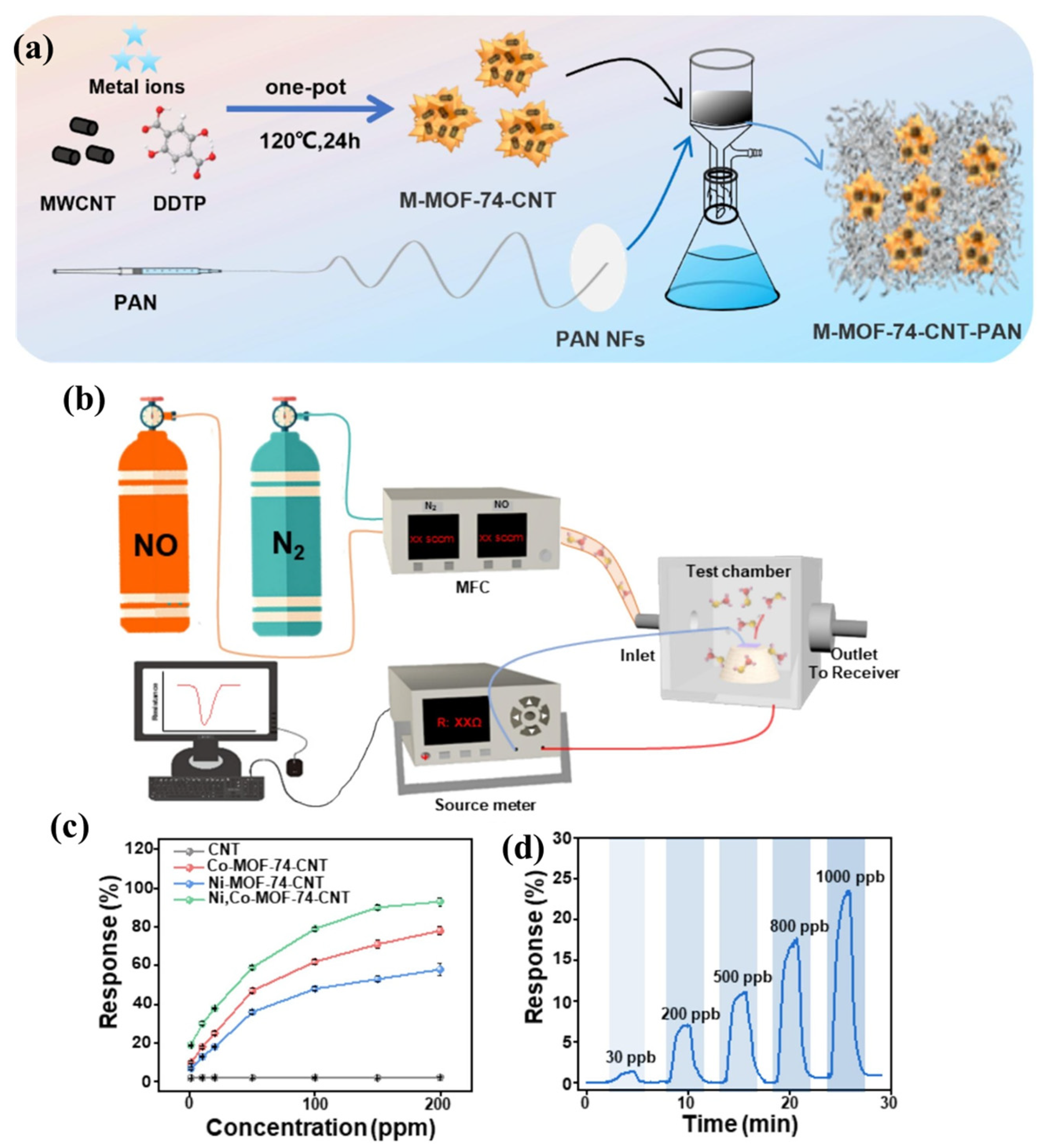
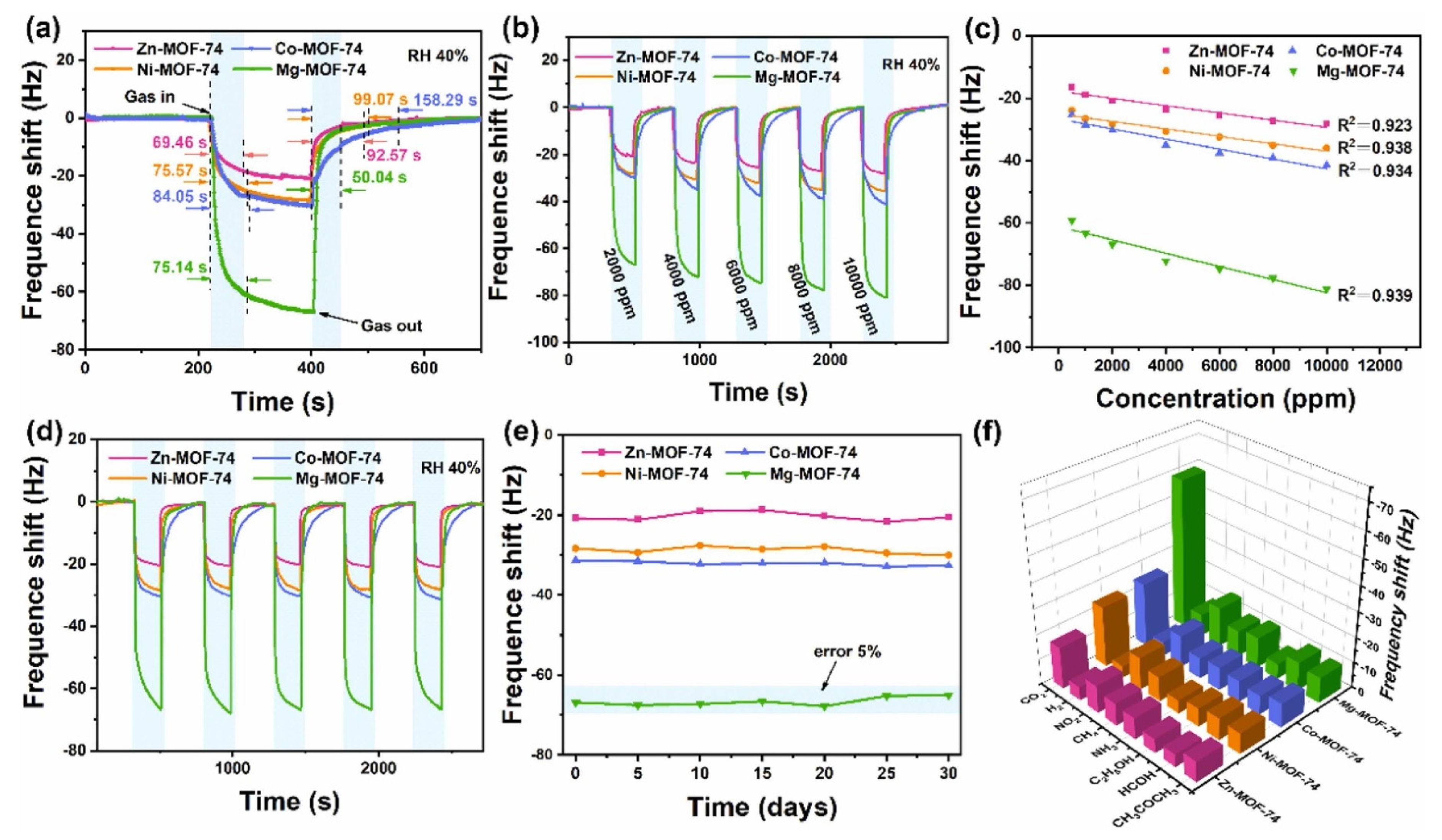

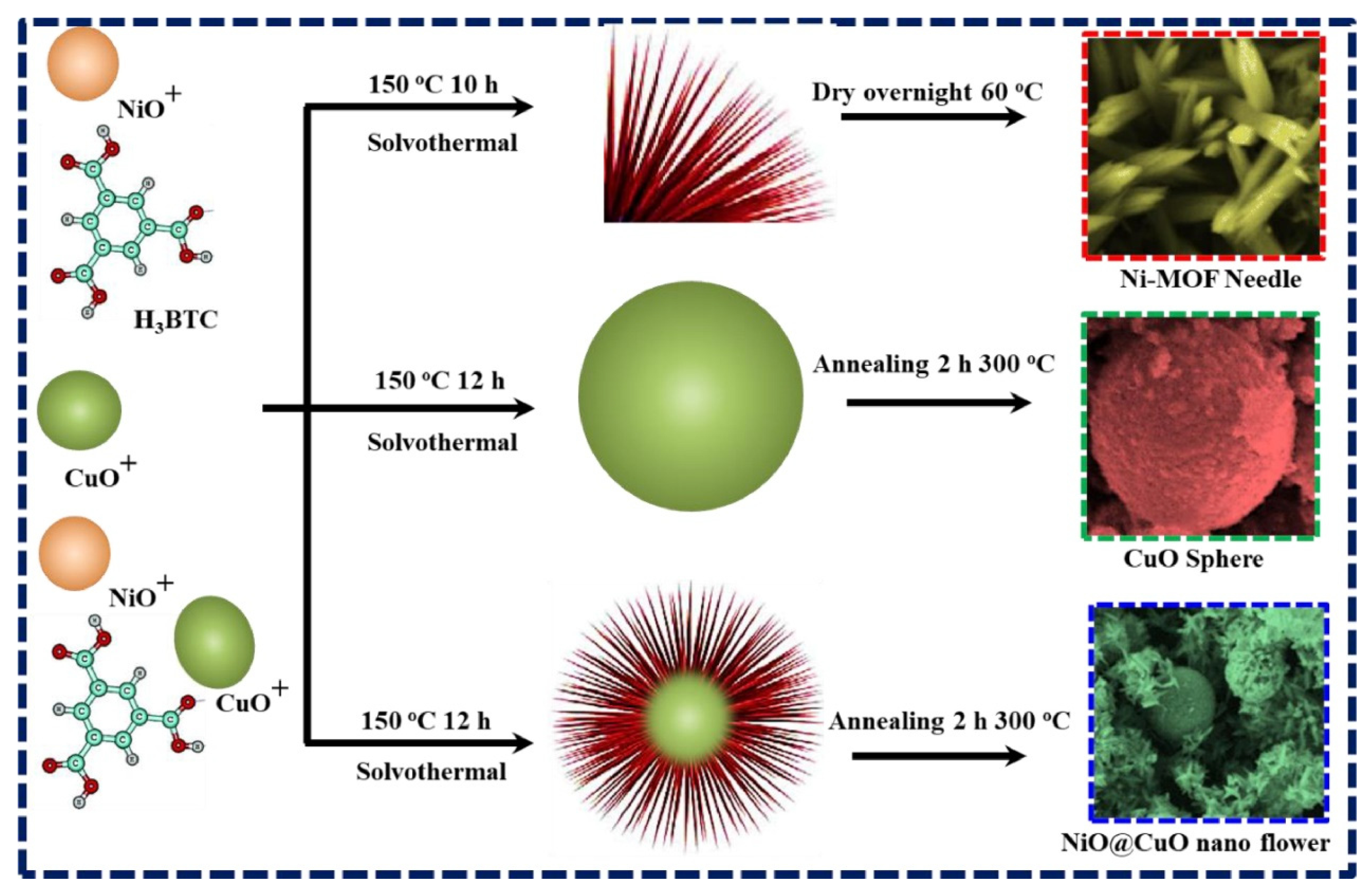
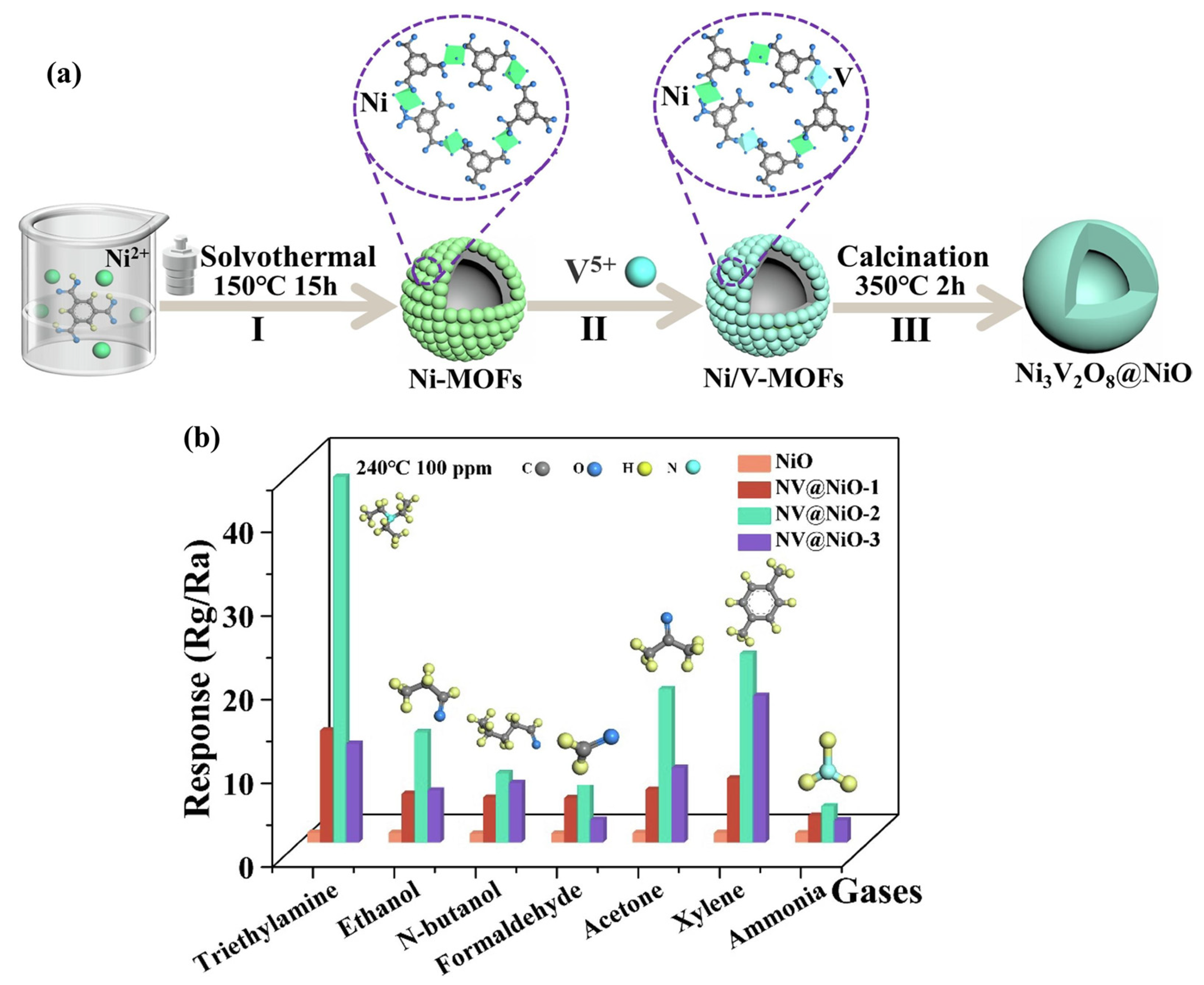
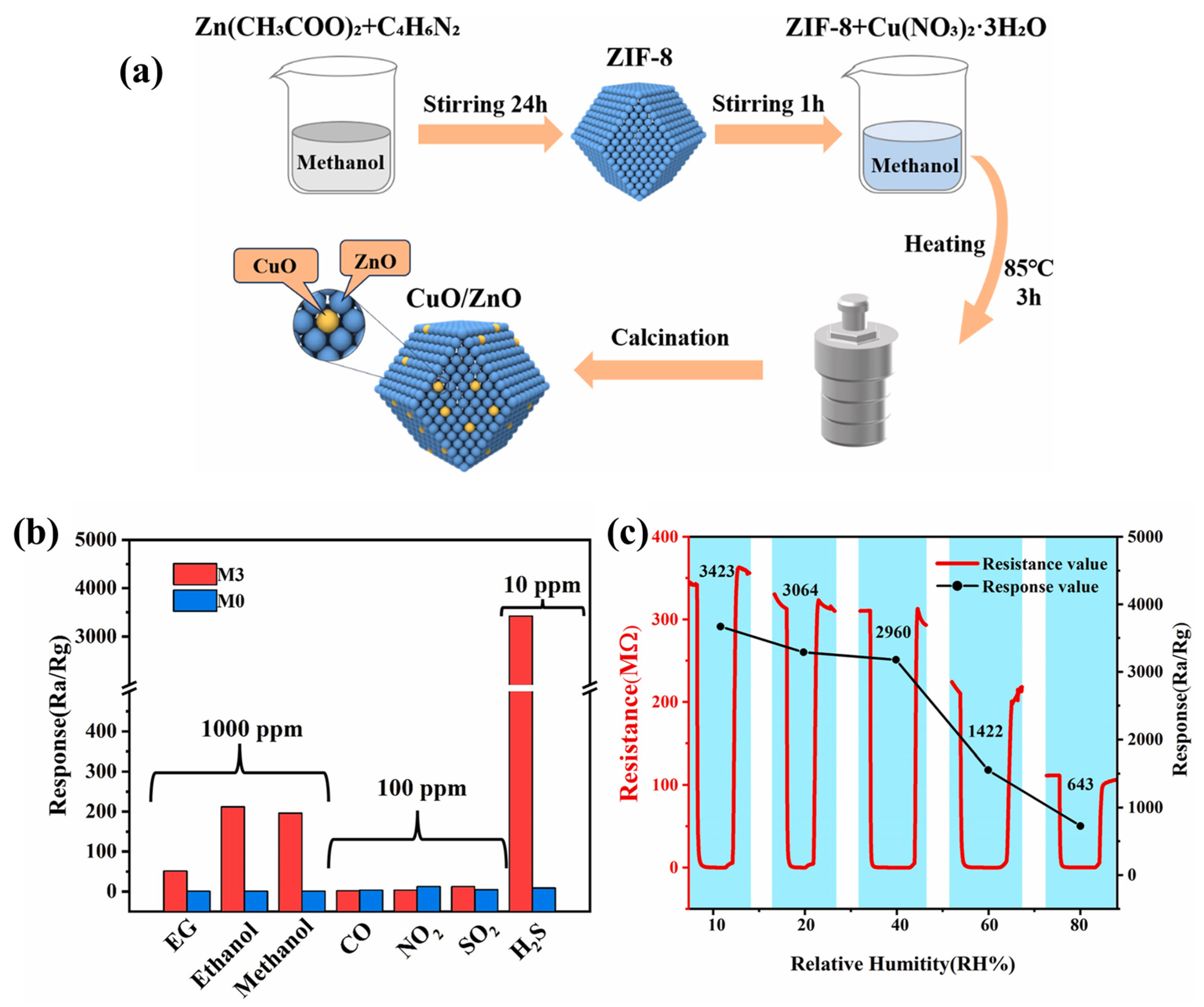
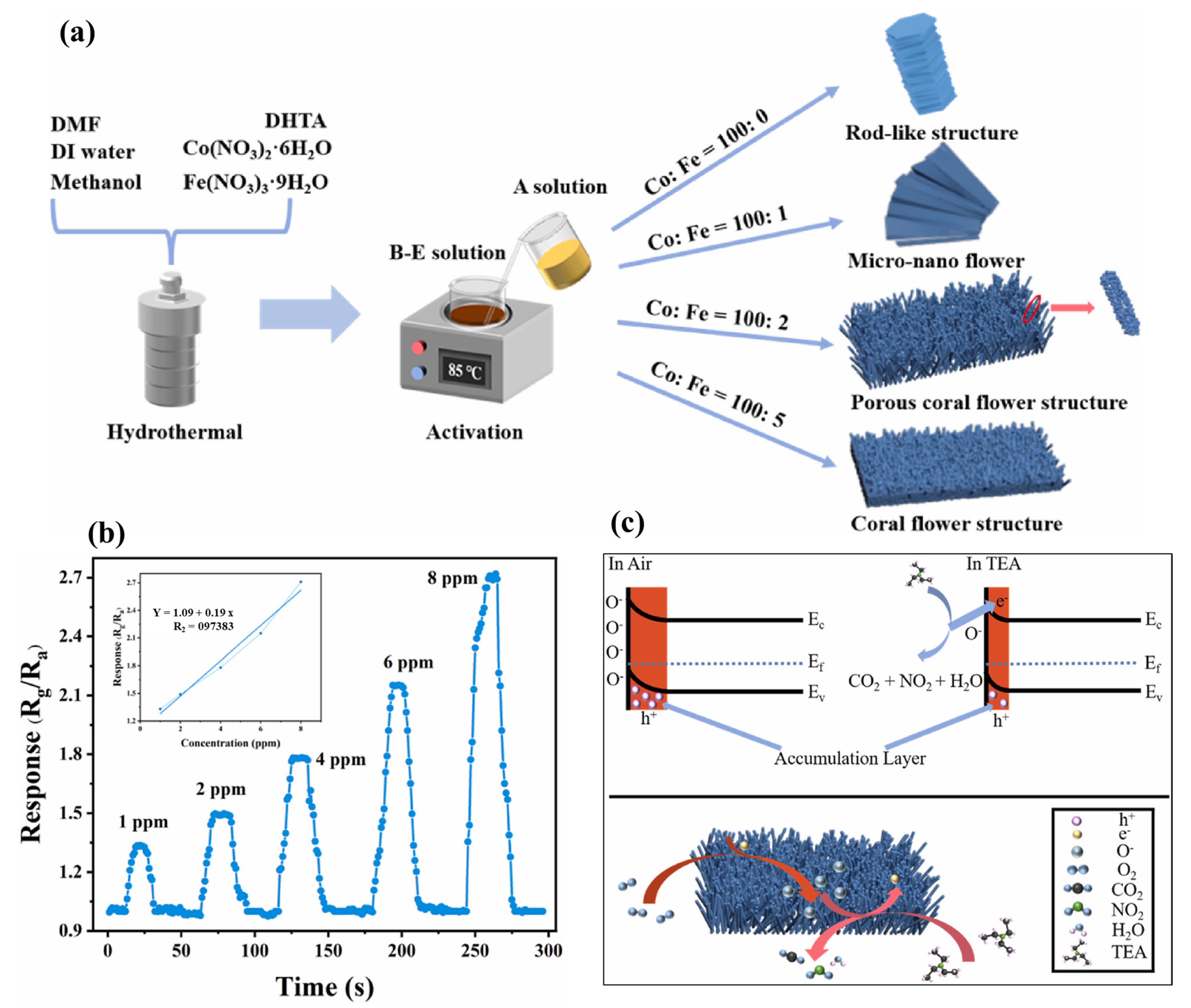
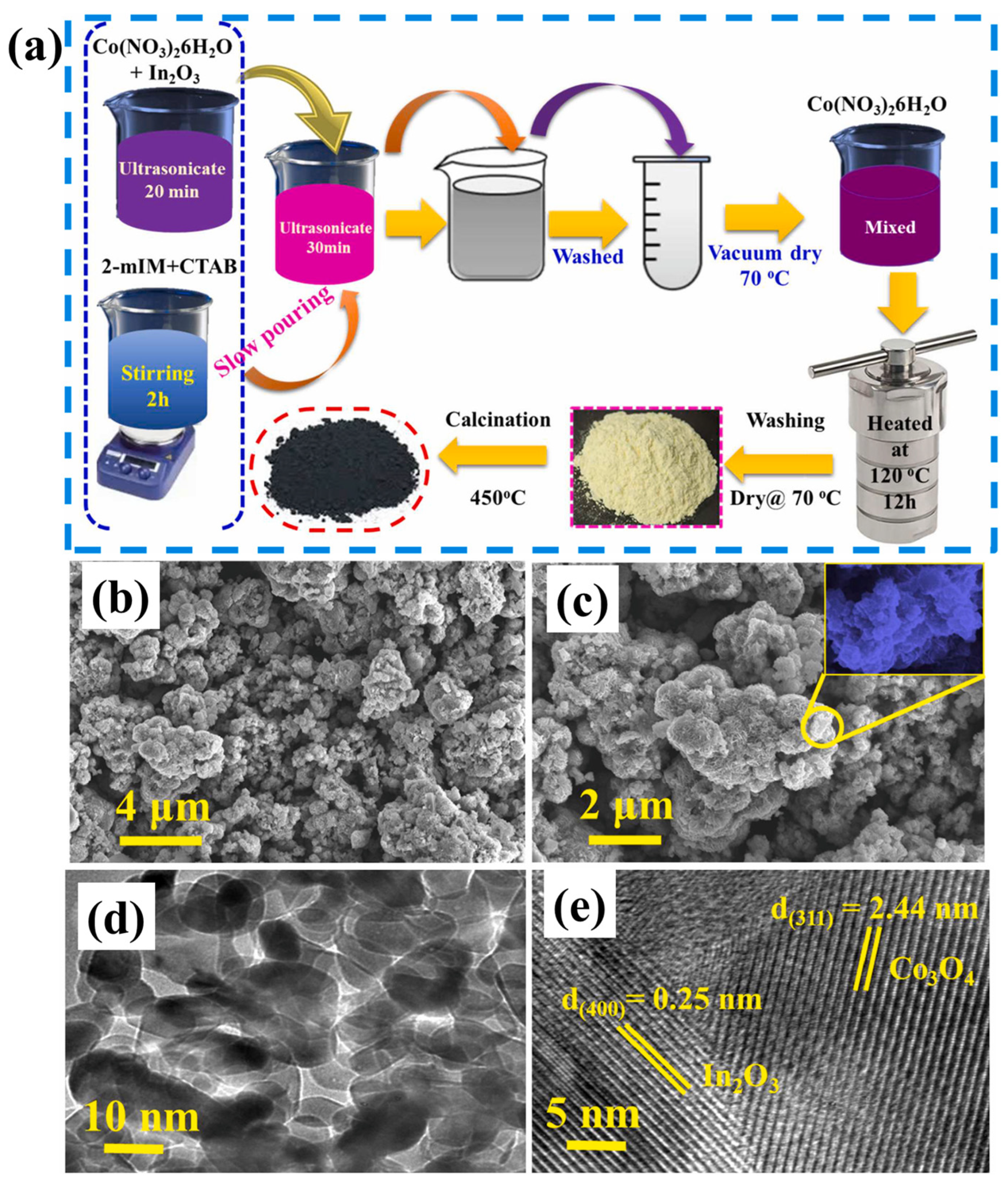
| Materials | Analyte | Response/Recovery Time (s) | LOD | References |
|---|---|---|---|---|
| P2@CuBTC | CO | 31 | 50 ppm | [41] |
| Cu-MOFs | DMC | - | 53 ppb | [44] |
| Cu3(HITP)2 | NH3 | 26 | 0.015 ppm | [45] |
| La-Ce-MOF | TMA | 30 | 0.16 µmoL/L | [46] |
| La-Ce-MOF | DMA | 45 | 0.35 µmoL/L | [46] |
| La-Ce-MOF | NH3 | 70 | 0.94 µmoL/L | [46] |
| La-Ce-MOF | HCHO | 90 | 1.42 µmoL/L | [46] |
| Pd-Co3O4@MOF | Acetone | 36 | 417 ppb | [47] |
| Ni, Co-MOF-74-CNT | NO | - | 18.6 ppb | [48] |
| V-MOF120(PTA) | NO2 | - | 1 ppm | [49] |
| 3wt%(Cu–S)nMOF-PANI | H2S | 15 | 0.5 ppm | [50] |
| Mg-doped MOF-ZnO | Butanol | 12 | 200 ppb | [52] |
| Fe/Co MOF HG | Acetone | 77 | 103 ppb | [53] |
| Zn-MOF-210 | Butanol | - | 0.431 ppb | [54] |
| Co-MOF@MXene | H2S | - | 50 ppb | [58] |
| Ti3C2Tx/Co-BDC | TEA | 11 | 0.085 ppb | [59] |
| SnO2-M-OV-300 | NO2 | 33 | 0.001 ppm | [60] |
| PdNPs-SWCNTs@Cu-MOF-74 | Ethylene | - | 31 ppb | [61] |
| 10%ZIF-8/MoO3 | H2S | 20 | - | [62] |
| Materials | Analyte | Response/Recovery Time (s) | LOD | References |
|---|---|---|---|---|
| WO3/ZnWO4/CoWO4 | Butanol | 115/179 | - | [63] |
| NiO@CuO NFs | H2 | 100/167 | 20 ppm | [64] |
| SnO2-Ce-0.75 | Ethylene glycol | 13/3 | - | [65] |
| Mo-Co3O4 | CO | 78.5/55.3 | 0.195 ppm | [66] |
| NV@NiO-2 | TEA | 88/127 | 4.5 ppb | [67] |
| CuO/ZnO | H2S | 10 | 100 ppb | [68] |
| Co3O4/Fe2O3 | TEA | 13/15 | 1 ppm | [70] |
| In2O3/Co3O4 | NH3 | 92/51 | 0.5 ppm | [71] |
| In-Co3O4 | H2S | - | 1.8 ppm | [72] |
| Co3O4 | H2S | 63.56/103.34 | 500 ppb | [74] |
| CuO NPs/Ti3C2TX | NO2 | - | 30 ppb | [75] |
| NiO/ZrO2-2 | TEA | 55/83 | 7.2 ppb | [76] |
| In2O3/ZnCo2O4-2 | Butanol | 152/223 | 4.2 ppb | [77] |
| Sn/W-NiO | TEA | - | 0.1 ppm | [78] |
| Au-CeO2/Co3O4 | Toluene | 53/34 | 0.1 ppm | [79] |
| 5.0Pd-NPs@ZnO | H2 | - | <10−3 ppm | [80] |
| Al3+-Co3O4 | Butanol | - | 0.4 ppm | [81] |
| N-doped SnO2-rGO | NO2 | - | 1 ppm | [82] |
| Cr2O3/RGO | Butanol | 150/250 | 8.6 ppb | [84] |
| MoO3/TiO2-X | TEA | 19/23 | - | [86] |
| ZCP50 | NH3 | 115/169 | 0.1 ppm | [87] |
| NiO-SnO2 | NO2 | 86.8/29.4 | 25 ppb | [88] |
| Amorphous ZIF-67 derivative | TEA | 125/88 | - | [90] |
| 3Mn-In2O3 nanotubes | H2 | 4/15 | 0.025 ppm | [91] |
| Cu2O/CuO-C | NO2 | - | 7 ppb | [92] |
| ZnCo2O4 flower | Methane | 14/20 | - | [93] |
Disclaimer/Publisher’s Note: The statements, opinions and data contained in all publications are solely those of the individual author(s) and contributor(s) and not of MDPI and/or the editor(s). MDPI and/or the editor(s) disclaim responsibility for any injury to people or property resulting from any ideas, methods, instructions or products referred to in the content. |
© 2025 by the authors. Licensee MDPI, Basel, Switzerland. This article is an open access article distributed under the terms and conditions of the Creative Commons Attribution (CC BY) license (https://creativecommons.org/licenses/by/4.0/).
Share and Cite
Ahmad, K.; Oh, T.H. Recent Progress in MOFs and MOF-Derived Materials for Gas Sensing Applications. Chemosensors 2025, 13, 100. https://doi.org/10.3390/chemosensors13030100
Ahmad K, Oh TH. Recent Progress in MOFs and MOF-Derived Materials for Gas Sensing Applications. Chemosensors. 2025; 13(3):100. https://doi.org/10.3390/chemosensors13030100
Chicago/Turabian StyleAhmad, Khursheed, and Tae Hwan Oh. 2025. "Recent Progress in MOFs and MOF-Derived Materials for Gas Sensing Applications" Chemosensors 13, no. 3: 100. https://doi.org/10.3390/chemosensors13030100
APA StyleAhmad, K., & Oh, T. H. (2025). Recent Progress in MOFs and MOF-Derived Materials for Gas Sensing Applications. Chemosensors, 13(3), 100. https://doi.org/10.3390/chemosensors13030100




